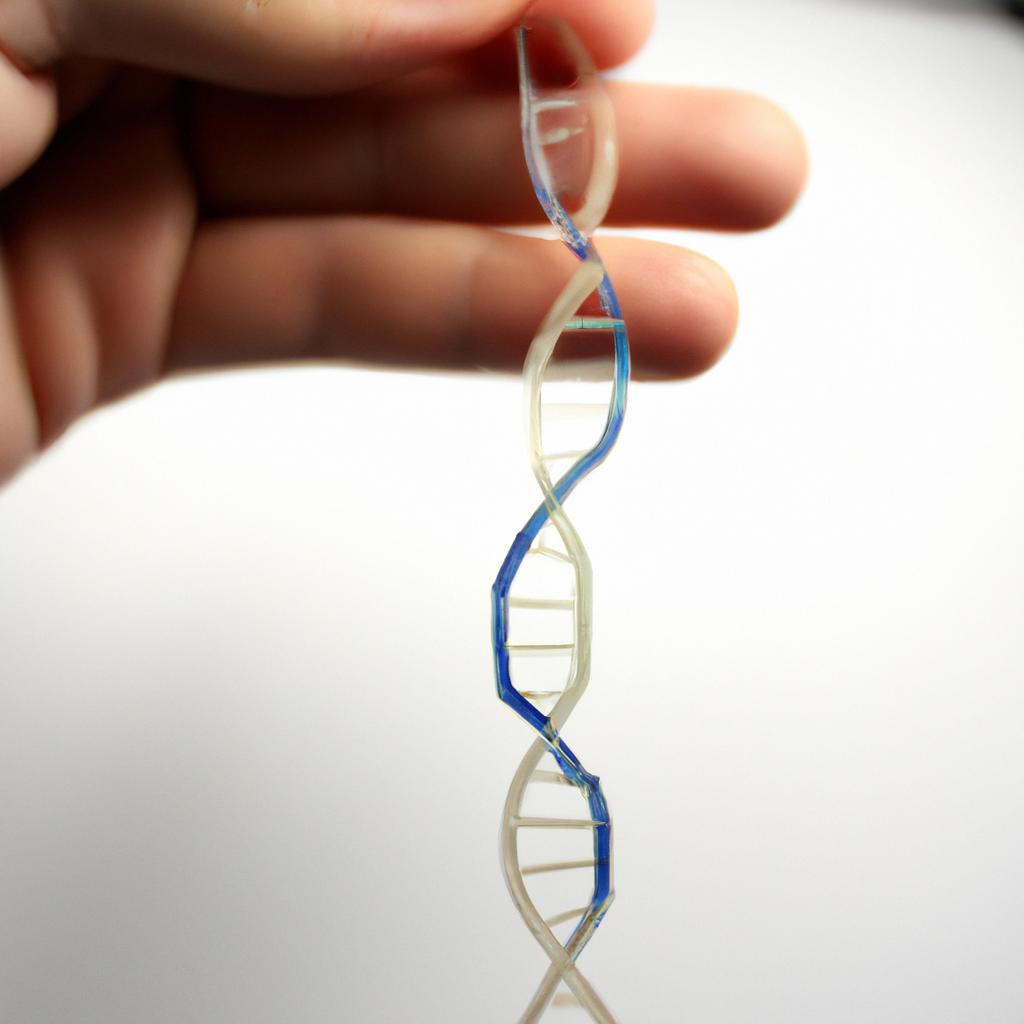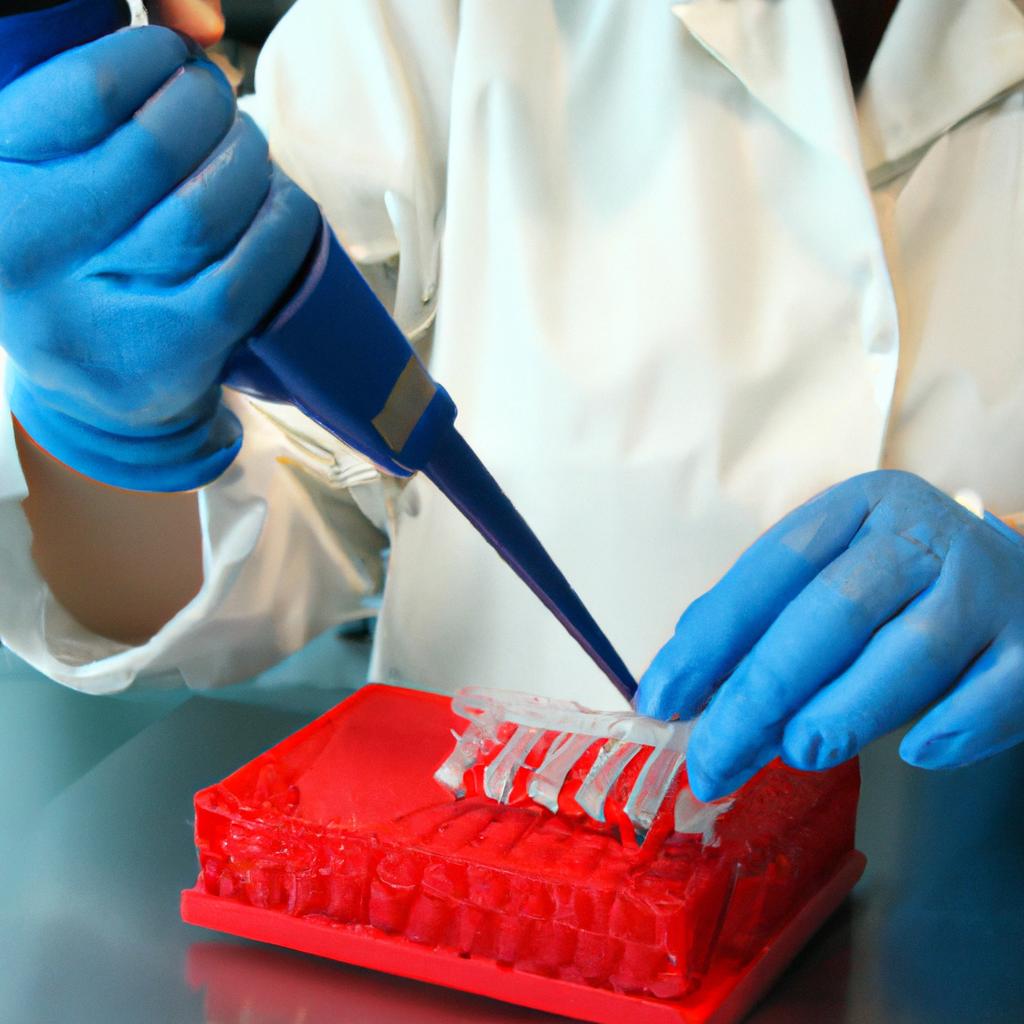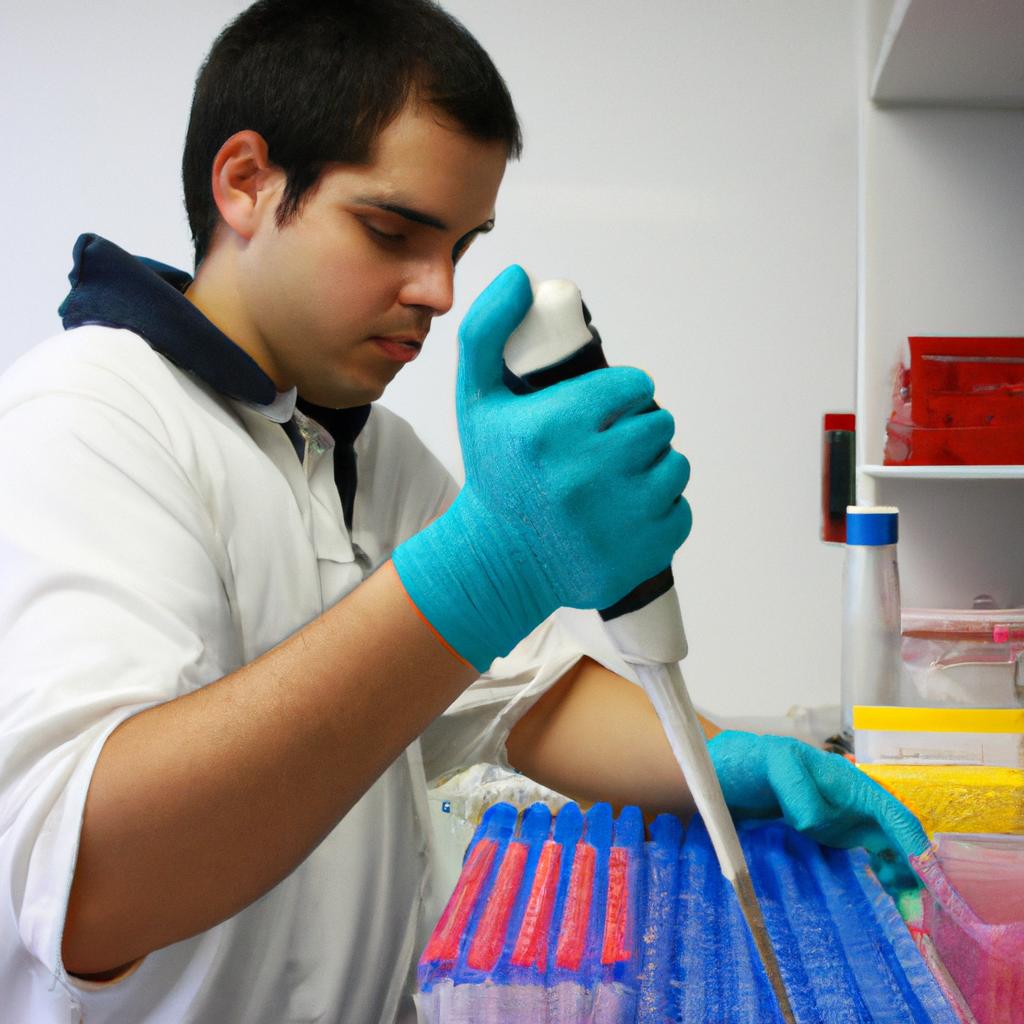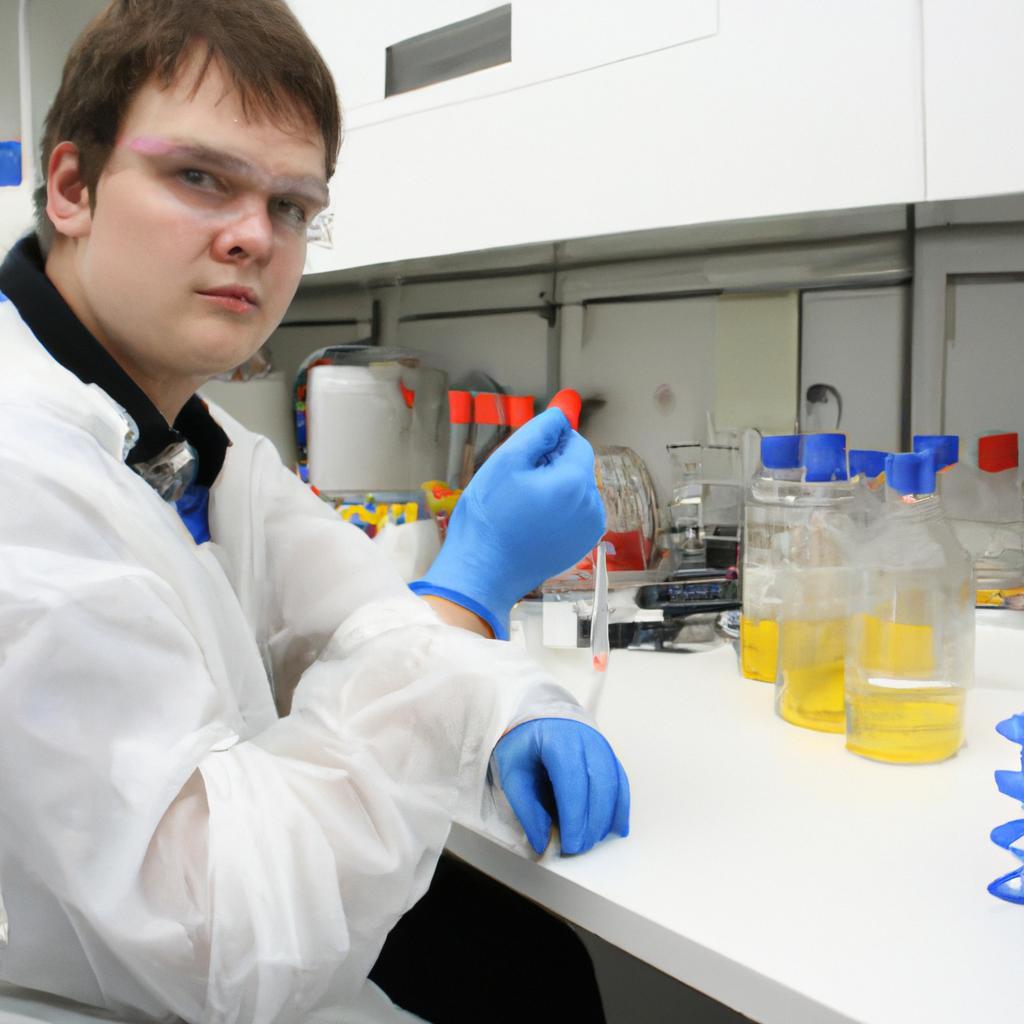Understand Gene Expression: Insights into Genetics in Science Biology

Gene expression is a fundamental process that plays a crucial role in the understanding of genetics and its implications in various scientific disciplines. By unraveling the intricate mechanisms behind gene expression, scientists have gained valuable insights into the complex world of biology. For instance, consider the case study of a remarkable genetic disorder known as cystic fibrosis. This condition arises due to mutations in the CFTR gene, resulting in defective chloride ion channels on cell surfaces. Understanding how these mutations affect gene expression sheds light on the underlying molecular basis of cystic fibrosis and opens up avenues for potential therapeutic interventions.
Exploring gene expression provides us with an opportunity to delve deeper into the intricacies of genetics and decipher how genes are regulated within cells. The regulation of gene expression determines when and where specific genes are switched on or off, influencing cellular functions and phenotypic traits. This regulatory mechanism involves a series of events, including transcription, mRNA processing, translation, and post-translational modifications. It is through these processes that DNA sequences are transcribed into functional proteins or non-coding RNA molecules. Consequently, studying gene expression not only enhances our comprehension of genetic diseases but also uncovers novel targets for drug development and therapies.
In this article, we aim to provide a comprehensive overview of the mechanisms and importance of gene expression in various biological processes. We will discuss the different levels of regulation, such as transcriptional control, epigenetic modifications, and post-transcriptional modifications. Additionally, we will explore the role of gene expression in development, disease progression, and response to environmental stimuli. Furthermore, we will highlight cutting-edge techniques and technologies used to study gene expression, including RNA sequencing and single-cell analysis. By the end of this article, readers will have a thorough understanding of how gene expression contributes to our understanding of biology and its potential applications in medicine and biotechnology.
What is gene expression?
Gene expression refers to the process by which genetic information encoded in a gene is converted into functional molecules such as proteins or RNA. It plays a crucial role in determining an organism’s characteristics and functions, making it a fundamental concept in biology. To grasp the significance of gene expression, consider the example of lactose metabolism in bacteria.
Bacteria possess genes that allow them to metabolize lactose, but these genes are not always active. In the absence of lactose, certain regulatory mechanisms prevent their expression. However, when lactose becomes available as a nutrient source, specific proteins are produced through gene expression to break down lactose into usable components. This allows the bacterium to efficiently utilize lactose for energy production.
Understanding gene expression has far-reaching implications across various fields of study. Here are some key reasons why this topic holds immense importance:
- Medical Applications: Gene expression profiling can help identify disease biomarkers and provide insights into understanding complex diseases such as cancer or neurological disorders.
- Developmental Biology: Studying gene expression during embryonic development elucidates how different cell types arise from identical genetic material.
- Evolutionary Studies: Comparing gene expression patterns among species provides valuable information about evolutionary relationships and adaptations.
- Pharmacology: Examining changes in gene expression following drug administration aids in predicting drug efficacy and optimizing treatment strategies.
In summary, comprehending the intricacies of gene expression expands our knowledge about biological processes at molecular levels and enables us to unravel numerous scientific mysteries. The next section will delve deeper into why exactly gene expression is essential for better grasping its true significance.
Why is gene expression important? Understanding its relevance yields remarkable insight into genetics’ profound influence on living organisms.
Why is gene expression important?
Understanding Gene Expression: Insights into Genetics in Science Biology
What is gene expression? In the previous section, we explored the concept of gene expression and how it plays a fundamental role in shaping an organism’s traits. Now, let us delve deeper into why gene expression is important and its implications in various biological processes.
Gene expression serves as a molecular blueprint that guides the synthesis of proteins necessary for cellular functions. To illustrate this significance, consider a hypothetical scenario where a mutation occurs in a key regulatory gene responsible for insulin production. As a result, the altered gene fails to initiate the proper sequence of events required for insulin synthesis. This disruption leads to decreased or absent insulin levels, ultimately resulting in diabetes mellitus. This example highlights how malfunctioning gene expression can have serious consequences on an individual’s health.
To further grasp the importance of gene expression, here are some key points to consider:
- Gene regulation: Proper control of gene expression ensures that genes are activated only when needed and silenced when not required.
- Developmental processes: Gene expression patterns dictate embryonic development, tissue differentiation, and organ formation.
- Disease mechanisms: Dysregulation of gene expression has been linked to numerous diseases such as cancer and neurodegenerative disorders.
- Pharmacogenomics: Understanding variations in gene expression among individuals helps optimize drug therapies tailored to specific genetic profiles.
Now, let us explore these concepts through a table showcasing examples of different genes and their associated functions:
| Gene | Function |
|---|---|
| TP53 | Tumor suppressor |
| CFTR | Ion channel |
| BRCA1/2 | DNA repair |
| OCT4 | Pluripotency maintenance |
The emotions evoked by considering these diverse functionalities range from awe at nature’s complexity to concern over potential health risks. By highlighting these connections between genes and their roles within organisms, we gain valuable insights into the intricate world of gene expression.
In the subsequent section, we will delve into how gene expression occurs and unravel the molecular mechanisms behind this complex process. Understanding these steps is crucial for comprehending the intricacies of genetics and its impact on living organisms.
How does gene expression occur?
Understanding the process of gene expression is crucial in unraveling the intricacies of genetics. In this section, we will explore how gene expression occurs and delve into its underlying mechanisms.
To illustrate the concept, let’s consider an example involving a cell that needs to produce a specific protein for cellular function. The first step in gene expression is transcription, where DNA is transcribed into messenger RNA (mRNA) by RNA polymerase. This mRNA molecule carries the genetic information from the nucleus to the cytoplasm, acting as a template for translation.
Once in the cytoplasm, translation takes place. Ribosomes attach to the mRNA and read its nucleotide sequence, using it as instructions to synthesize a chain of amino acids called a polypeptide. These amino acids are then folded and modified to form a functional protein. Ultimately, this protein plays a vital role in carrying out various biological processes within the cell.
Now let’s take a closer look at some key components involved in gene expression:
- Promoters: These regions on DNA act as signals for RNA polymerase to initiate transcription.
- Enhancers: Found upstream or downstream from promoters, enhancers enhance or increase the level of transcription of particular genes.
- Transcription factors: These proteins bind to specific sequences on DNA and play a critical role in regulating gene expression.
- Epigenetic modifications: Chemical modifications such as methylation can alter chromatin structure and impact gene expression patterns.
Table 1 summarizes these components:
| Component | Function |
|---|---|
| Promoters | Initiate transcription |
| Enhancers | Increase transcription levels |
| Transcription Factors | Regulate gene expression |
| Epigenetic Modifications | Influence chromatin structure and affect gene regulation |
As we have seen, understanding gene expression provides insights into how genetic information is utilized by cells. By studying these intricate processes, researchers aim to uncover the underlying mechanisms that govern gene expression and its regulation.
What are the factors that regulate gene expression?
Building upon our understanding of how gene expression occurs, let us now delve into the fascinating world of factors that regulate this intricate process. Through a closer examination of these regulatory mechanisms, we can gain further insights into the complex interplay between genes and their environment.
Regulating gene expression involves a multitude of factors that act in concert to fine-tune genetic activity. To illustrate this, consider a hypothetical scenario where an organism is exposed to high levels of stress over an extended period. In response to this environmental stimulus, certain genes involved in stress response pathways may become upregulated, leading to an increased production of stress-related proteins. This example highlights the dynamic nature of gene regulation and its ability to adapt organisms’ molecular machinery according to changing external conditions.
Understanding the intricacies of gene regulation requires knowledge about various key players involved in shaping gene expression patterns. Several determinants have been identified through extensive research:
- Transcription Factors: These protein molecules bind specific DNA sequences near genes, either enhancing or repressing their transcription rates.
- Epigenetic Modifications: Chemical modifications on DNA or associated histone proteins can alter chromatin structure and accessibility, thereby influencing gene expression.
- Non-coding RNAs (ncRNAs): These RNA molecules do not code for proteins but play crucial roles in regulating gene expression at different stages.
- Environmental Influences: External factors such as temperature, light exposure, nutrient availability, and chemical signals can profoundly impact gene expression profiles.
| Regulatory Factor | Mechanism | Example |
|---|---|---|
| Transcription Factors | Bind DNA sequences near genes | Upregulation of heat shock proteins under heat stress |
| Epigenetic Modifications | Alter chromatin structure/accessibility | Methylation of tumor suppressor gene leading to its silencing |
| Non-coding RNAs | Regulate RNA stability, translation, and more | MicroRNA inhibiting expression of oncogenes |
| Environmental Influences | Impact gene expression profiles | Altered flowering time in response to photoperiod |
By understanding the intricate interplay between these regulatory factors, scientists can unravel the complex mechanisms governing gene expression. This knowledge enables us to gain insights into how organisms respond and adapt to their environment at a molecular level.
Having explored the factors that regulate gene expression, we now turn our attention towards examining the consequences that arise when this delicate balance is disrupted. What are the implications when genes fail to express themselves as intended? Let us explore further.
What are the consequences of altered gene expression?
Factors that Influence Gene Expression
In the previous section, we explored the various factors that regulate gene expression. Now, let us delve deeper into understanding the consequences of altered gene expression and its implications in genetics.
Consider a hypothetical scenario where a mutation occurs in a specific gene responsible for producing an essential enzyme involved in cellular metabolism. As a result of this mutation, the gene’s expression is significantly reduced. This reduction leads to a decrease in enzyme production, ultimately affecting metabolic processes within the cell.
The consequences of altered gene expression can be far-reaching and have profound effects on an organism. Here are some key aspects to consider:
-
Developmental Abnormalities: Altered gene expression during embryonic development can lead to structural abnormalities or functional impairments in organs or tissues. For instance, downregulation of certain genes involved in limb formation may result in limb malformation or absence.
-
Disease Susceptibility: Changes in gene expression can influence an individual’s susceptibility to diseases. Upregulated oncogenes (genes associated with cancer development) can increase the risk of developing certain types of cancers, while downregulation of tumor suppressor genes may compromise the body’s ability to control abnormal cell growth.
-
Drug Response Variability: Differences in gene expression among individuals can contribute to variations in drug responses. Some people may metabolize medications more efficiently due to upregulated enzymes involved in drug metabolism, leading to faster clearance rates and potential treatment inefficacy.
-
Environmental Interactions: External factors such as stress, diet, pollutants, and lifestyle choices can impact gene expression patterns. These interactions between genetic predispositions and environmental influences play a crucial role in shaping an individual’s overall health and well-being.
To further illustrate these concepts visually, here is a table showcasing examples of altered gene expression and their corresponding consequences:
| Altered Gene Expression | Consequences |
|---|---|
| Increased Oncogene | Higher cancer risk |
| Downregulated Enzyme | Metabolic dysfunction |
| Upregulated Drug Efflux | Decreased drug effectiveness |
| Stress-Responsive Genes | Impaired stress response |
Understanding the factors that influence gene expression is essential in comprehending the intricate workings of genetics. It allows us to investigate how genes behave under different circumstances and sheds light on the underlying mechanisms behind various biological phenomena.
In our next section, we will explore how researchers study gene expression in the field of biology, providing insights into the techniques and methodologies employed to unravel this complex process.
How is gene expression studied in the field of biology?
Exploring the Impact of Altered Gene Expression
Altered gene expression can have profound consequences on an organism’s phenotype and overall health. By examining specific examples, we can gain a deeper understanding of how these alterations manifest in real-life scenarios. Consider the case study of a genetic disorder called cystic fibrosis (CF), which is caused by mutations in the CFTR gene.
One consequence of altered gene expression in individuals with CF is the production of abnormal or malfunctioning CFTR protein channels. These channels are responsible for regulating salt and water movement across cell membranes, particularly in epithelial tissues such as those lining the lungs and digestive system. In affected individuals, faulty CFTR channels lead to thickened mucus secretions, impaired clearance mechanisms, and increased susceptibility to respiratory infections. This example highlights just one instance where altered gene expression results in significant physiological changes.
To further comprehend the impact of altered gene expression at a broader level, let us explore some key points:
- Alterations in gene expression can occur due to various factors, including genetic mutations, environmental influences, or epigenetic modifications.
- Dysregulation of gene expression has been linked to numerous diseases and disorders ranging from cancer to neurodegenerative conditions.
- Understanding how genes are regulated and deciphering their intricate network interactions enables scientists to develop targeted therapies that aim to correct aberrant gene expression patterns.
- Studying gene expression also allows researchers to identify potential biomarkers for disease diagnosis and prognosis.
Now, let us delve into a three-column table highlighting different aspects related to altered gene expression:
| Factors Influencing Altered Gene Expression | Consequences | Research Techniques |
|---|---|---|
| Genetic Mutations | Developmental Defects | DNA Microarrays |
| Environmental Influences | Disease Susceptibility | RNA Sequencing |
| Epigenetic Modifications | Aging Processes | Chromatin Immunoprecipitation (ChIP) |
| Transcription Factors | Drug Response | Reporter Gene Assays |
By examining these various factors and their corresponding consequences, it becomes evident that altered gene expression plays a significant role in shaping both normal development and disease progression. Continued research into the mechanisms underlying gene expression regulation will not only deepen our understanding of genetics but also provide potential avenues for therapeutic interventions.
In summary, altered gene expression can have far-reaching effects on an organism’s health and well-being. By investigating real-life examples like cystic fibrosis, we gain insight into how genetic alterations impact various physiological processes. Understanding the factors influencing gene expression and employing advanced research techniques allows researchers to unravel the complexities of genetics and develop innovative strategies to address diseases stemming from such alterations.









